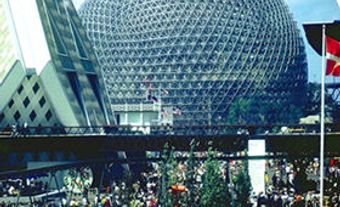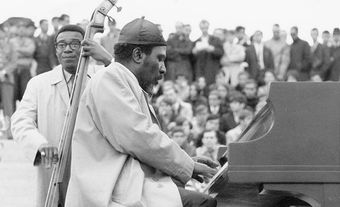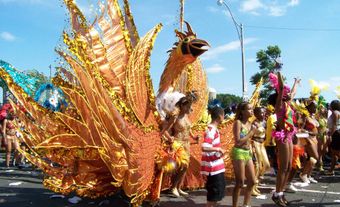World exposition sanctioned by the International Bureau of Expositions, held in Vancouver 2 May-30 Oct 1986. The theme, Transportation and Communication, celebrated the centenaries of the founding of Vancouver and the arrival on the Pacific coast of the first passenger train. Fifty-four governments and industries from six continents participated and there were over 22 million individual visits to the site. The commissioner general was Patrick Reid.
Located along Vancouver's inner-city waterway, the 70 hectare site featured over 80 pavilions and many indoor and outdoor performance venues. including the Xerox International Theatre, a 1500-seat outdoor ampitheatre; The Big House, a 400-seat theatre of longhouse design; The Barn, a 300-seat proscenium theatre; and the Street of the Expo site on which a street festival took place throughout the exposition's run. The Canadian Pavilion, separate from the main site but accessible to visitors by a four-minute ride on Vancouver's new Advanced Light Rapid Transit system, housed five performance spaces including a 500-seat outdoor ampitheatre, the 380-seat Amiga Studio (the exhibition's only enclosed theatre), and the 350-seat Inner Stage.
Music was integral to the planning of Expo 86. Its chairman, Jim Pattison, directed that there be 'joyous music from morning to midnight' and that each performing place be acoustically separate from its neighbours. John Cripton, producer of entertainment for the Canada Pavilion, brought together, in his words, 'the largest festival of Canadian artists ever assembled - over 13,000 hours of performances,' while Ann Farris Darling, producer of Expo's World Festival, invited artists from around the world for a festival dedicated to music, language, and movement.
The Government of Canada contributed $9.8 million to cultural projects ($5.8 million for the program at the Canada Pavilion, $2 million to enable Canadian artists to tour to other centres en route to or from the exposition, $1.5 million for Canadian participation in the World Festival and $500,000 to cultural projects of Vancouver's centennial celebrations).
On-site Music
On-site entertainment presented by the participating nations' artists offered thousands of events, most of them free, including performances of pop, jazz, blues, rock, folk, aboriginal, ethnic, and classical music. These included performances by the Canadian Children's Opera Chorus, the Confederation Centre Boys' Choir, the Elmer Iseler Singers, the Guelph Spring Festival (Peter Maxwell Davies' The Lighthouse), Maureen Forrester with the Toronto Children's Chorus, the Mormon Tabernacle Choir, Norwegian Rites, Canada Opera Piccola, an ensemble of the Saskatchewan Symphony Orchestra, A Touch of Brass, the Vancouver Chamber Choir with the Ensemble Vocal de Lausane, the Vancouver New Music Society and Steve Reich, the Vancouver Society for Early Music and Huelgas, the Vancouver Wind Trio, the Vancouver Youth Orchestra, and the Vancouver Symphony Orchestra.
The Canada pavilion presented Jazz Canada, a jam session by seven of Canada's leading musicians: Guido Basso, Ed Bickert, Jim Galloway, Rob McConnell, Ian Bargh, Terry Clarke and Neil Swainson. A military band from France, La Garde Republicaine, gave several performances as did the RCMP Stage Band.
Among the popular and folk musicians who appeared were Heather Bishop, Bruce Cockburn, Michael Cooney, Roy Forbes, Rufus Guinchard, Arlo Guthrie, Marie-Lynn Hammond, Rolf Harris, Ronnie Hawkins, the Junior Jug Band, Connie Kaldor, Kelly Russell, Alain Lamontagne, Loverboy, Rita MacNeil (performing solo and with the Men of the Deep), the Nylons, Jim Payne, the Peking Pop Orchestra, Pete Seeger, Stringband, Shari Ulrich, UZEB, and Nancy White. kd lang appeared several times, performing with the Edmonton Symphony Orchestra and with the Reclines. Other performances were given by Victor Borge, the Cambridge Buskers, the Glass Orchestra, Robert Minden (on musical saw and other unconventional instruments), and the Gospelairs from Nova Scotia.
Performers of traditional music came from Kenya, the Ivory Coast, Barbados, Thailand, Indonesia, Japan, Senegal, the Philippines, and from the Canadian Ukrainian and Rumanian communities.Performers of Canadian aboriginal music included David Campbell (songs of native experience), Le Carcajou (Montagnais song and dance), Inuit Throat Singers, and the NWT Arctic show (dance, drums, and Inuit heavy metal).
The Royal Bank/Expo 86 World Festival
The World Festival featured nearly 200 attractions including opera, ballet, and theatre companies, orchestras, chamber music ensembles, popular singers and comedians, who performed primarily for paying audiences off-site at the Orpheum, the Playhouse, and the Queen Elizabeth Theatre. The festival's opening gala in the Orpheum 2 May 1986 began with the premiere of Alexina Louie's fanfare The Ringing Earth. Sixteen concert and opera singers representing the global scope of Expo 86 appeared with the Vancouver Symphony Orchestra directed by Mario Bernardi in a program of arias, duets, and ensembles and Vaughan Williams' Serenade to Music.
There were two Vancouver Opera productions in the Orpheum: Carmen directed by Lucian Pintilie with Canadian mezzo soprano Jean Stilwell in the title role, and the North American premiere of Leos Janáček's From the House of the Dead. The La Scala production of Verdi's I Lombardi was performed, with English surtitles (for the first time in Vancouver), in the Pacific Coliseum.
The Vancouver SO melded its regular subscription series with the festival in five presentations. which included Kiri Te Kanawa with resident conductor Rudolf Barshai, Katia and Marielle Labeque with conductor Gerard Schwarz, Janet Baker with Barshai, Maurice André with Kazuyoshi Akiyama, Maureen Forrester with Akiyama, and a program with Ivo Pogorelich.
Visiting orchestras included the USSR State SO under Evgeny Svetlanov,the MSO under Charles Dutoit with soloist Angela Hewitt, both at the Orpheum, and with soloist Nigel Kennedy at the Expo Theatre, and the Philadelphia Orchestra under Riccardo Muti.
Choral performances were presented by the the Vancouver Bach Choir directed by Bruce Pullan (its program with the Vancouver SO, In Celebration of Whales, at the Vancouver Aquarium included John Tavener's The Whale, Jean Coulthard'sOverture and Fanfare, and the world premiere of Alan Hovaness' And God Created Great Whales, and was filmed by Rhombus Media); and La Scala twice performed Verdi's Requiem
The World Drum Festival under the artistic direction of John Wyre brought together from 17 countries 250 musicians representing a wide variety of the world's percussive styles. Some 3500 free performances were given in 25 different on-site locations 12-27 July, culminating in four Expo Theatre presentations featuring the massed forces of some 100 percussionists in a production composed and directed by John Wyre. Among the Canadian musicians taking part in the festival were Denne Drummers of Fort Rae, NWT; Inuit Drummers of Eskimo Point, NWT whose performances included traditional throat singing; Salvador Ferreras of Vancouver, performing a wide range of Latin, African, and jazz rhythms; Trichy Sankaran playing traditional Indian music as well as jazz and African styles; Themba Tana of Vancouver on traditional African instruments; and Nexus. Foreign performers came from the USA, the USSR, Korea, Pakistan, Japan, Great Britain and Thailand.
Other World Festival attractions included performances by the French ensemble Urban Saxophone; Placido Domingo with the Spanish company of singers and dancers, Antologia de la Zarzuela; and the closing gala at the Orpheum which featured the soprano Jessye Norman with the Vancouver SO.

 Share on Facebook
Share on Facebook Share on X
Share on X Share by Email
Share by Email Share on Google Classroom
Share on Google Classroom


